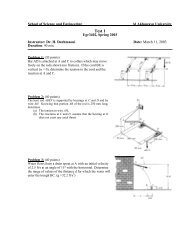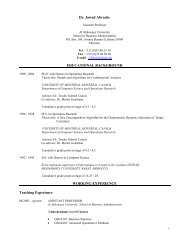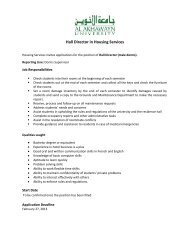Leadership and Values in Language Education - Al Akhawayn ...
Leadership and Values in Language Education - Al Akhawayn ...
Leadership and Values in Language Education - Al Akhawayn ...
- No tags were found...
Create successful ePaper yourself
Turn your PDF publications into a flip-book with our unique Google optimized e-Paper software.
92Proceed<strong>in</strong>gs of the 27 th MATE Annual Conferencepositive or negative feedback of the receiver, which could be verbal or nonverbal,often determ<strong>in</strong>es whether the message was adequately <strong>in</strong>terpreted or not.Accord<strong>in</strong>g to Samovar et al. (1981:13-14): “communication is complete onlywhen the <strong>in</strong>tended receiver perceives the message, attributes mean<strong>in</strong>g to it, <strong>and</strong> isaffected by it”. So a leader should constantly be aware of this fact so as to beready to adjust or change the direction of his speech to the end that convergeswith the needs of his followers if he claims to be empathetic <strong>in</strong> his relationship<strong>and</strong> democratic <strong>in</strong> his style of lead<strong>in</strong>g.This is not the case of a manager who acts as an <strong>in</strong>formation processor whose roleis to <strong>in</strong>form his employees <strong>in</strong> a neutral <strong>and</strong> sometimes <strong>in</strong> a mechanical waybecause he treats them like “objects” or numbers <strong>and</strong> does not care about theirfeel<strong>in</strong>gs <strong>and</strong> their feedback. Some managers stick to the rule “Hire <strong>and</strong> Fire”,which means that they can reject a worker any time if he does not satisfy thecompany <strong>and</strong> hire another worker immediately.It is undeniable that managers have a big communication responsibility whiledirect<strong>in</strong>g their company. What matters for them is to provide accurate<strong>in</strong>formation, sometimes supported with statistics. Another difference between aleader <strong>and</strong> a manager is that the former always tries to ‘communicate the wholepicture -the vision - rather than facts <strong>and</strong> pieces of <strong>in</strong>formation’ (see Daft, 1999).Thus, it is the duty of leaders to direct their followers’ attention toward the vision<strong>and</strong> values of their organization. To this effect, they may be compelled to usemany communication methods such as rich channels of communication, stories,metaphors <strong>and</strong> dialogue. This is briefly expla<strong>in</strong>ed below.2. An open Communication ClimateTo be successful <strong>and</strong> more fruitful, leadership communication requires an openclimate with<strong>in</strong> the organization <strong>in</strong> the sense that there should be felt equalitybetween all members <strong>in</strong> express<strong>in</strong>g their op<strong>in</strong>ions <strong>and</strong> shar<strong>in</strong>g <strong>in</strong>formation. Therelationship gets closer between the leader <strong>and</strong> his followers when his speech, hisactions <strong>and</strong> his behaviour truly reflect the ideas <strong>and</strong> values he embraces. Thefollowers feel secure <strong>and</strong> have no <strong>in</strong>feriority complex or psychological barrierss<strong>in</strong>ce the hierarchical levels are deliberately ignored. This ‘friendly’ environmentof communication, which is created by the talented <strong>and</strong> visionary leader, does alsoraise the followers self-esteem <strong>and</strong> motivation <strong>and</strong> consequently communicationcan be diffused easily <strong>in</strong> all directions <strong>in</strong> a constructive <strong>and</strong> transparent manner.This st<strong>and</strong>s <strong>in</strong> sharp contrast with management communication, where
















